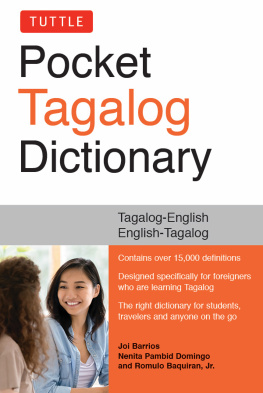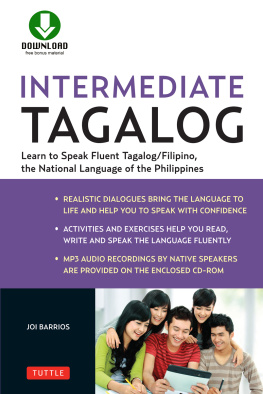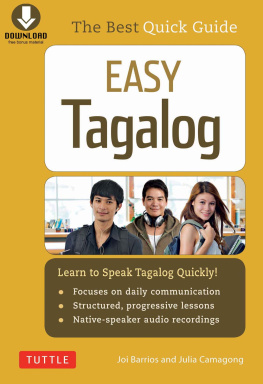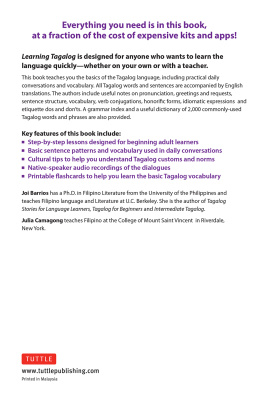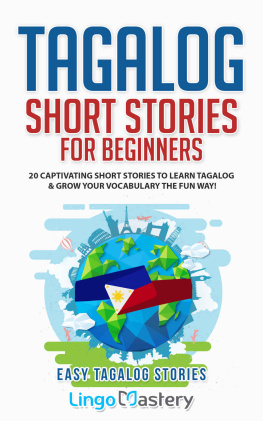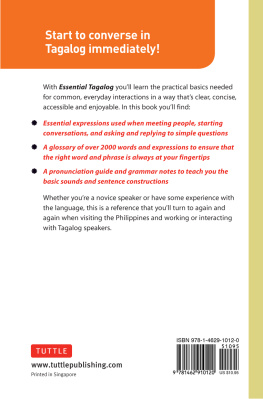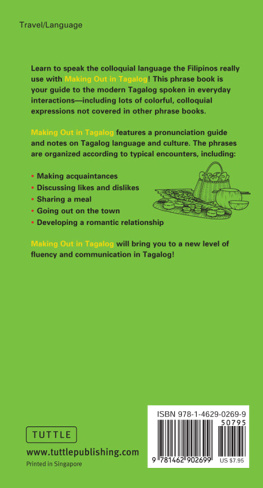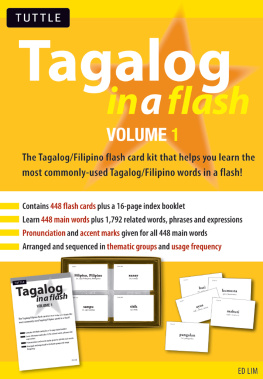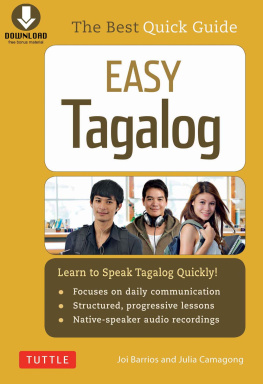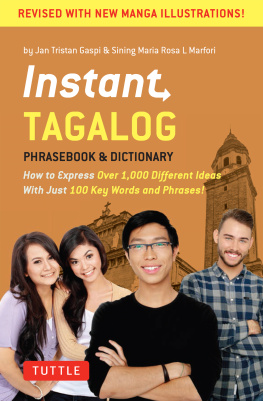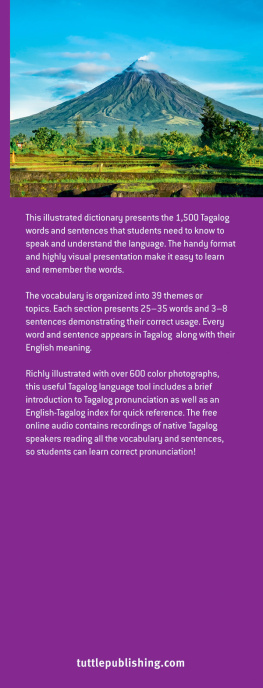Joi Barrios - Tuttle Pocket Tagalog Dictionary: Tagalog-English / English-Tagalog
Here you can read online Joi Barrios - Tuttle Pocket Tagalog Dictionary: Tagalog-English / English-Tagalog full text of the book (entire story) in english for free. Download pdf and epub, get meaning, cover and reviews about this ebook. publisher: Tuttle Publishing, genre: Home and family. Description of the work, (preface) as well as reviews are available. Best literature library LitArk.com created for fans of good reading and offers a wide selection of genres:
Romance novel
Science fiction
Adventure
Detective
Science
History
Home and family
Prose
Art
Politics
Computer
Non-fiction
Religion
Business
Children
Humor
Choose a favorite category and find really read worthwhile books. Enjoy immersion in the world of imagination, feel the emotions of the characters or learn something new for yourself, make an fascinating discovery.
- Book:Tuttle Pocket Tagalog Dictionary: Tagalog-English / English-Tagalog
- Author:
- Publisher:Tuttle Publishing
- Genre:
- Rating:3 / 5
- Favourites:Add to favourites
- Your mark:
- 60
- 1
- 2
- 3
- 4
- 5
Tuttle Pocket Tagalog Dictionary: Tagalog-English / English-Tagalog: summary, description and annotation
We offer to read an annotation, description, summary or preface (depends on what the author of the book "Tuttle Pocket Tagalog Dictionary: Tagalog-English / English-Tagalog" wrote himself). If you haven't found the necessary information about the book — write in the comments, we will try to find it.
Joi Barrios: author's other books
Who wrote Tuttle Pocket Tagalog Dictionary: Tagalog-English / English-Tagalog? Find out the surname, the name of the author of the book and a list of all author's works by series.
Tuttle Pocket Tagalog Dictionary: Tagalog-English / English-Tagalog — read online for free the complete book (whole text) full work
Below is the text of the book, divided by pages. System saving the place of the last page read, allows you to conveniently read the book "Tuttle Pocket Tagalog Dictionary: Tagalog-English / English-Tagalog" online for free, without having to search again every time where you left off. Put a bookmark, and you can go to the page where you finished reading at any time.
Font size:
Interval:
Bookmark:
TUTTLE
Pocket
Tagalog
Dictionary
Tagalog-English
English-Tagalog
Joi Barrios, Nenita Pambid Domingo and Romulo Baquiran, Jr.
Contributors: Marc Castillo, Agnes Magtoto,
Maria Cora Larobis and Teresita Raval

Published by Tuttle Publishing, an imprint of Periplus Editions (HK) Ltd.
www.tuttlepublishing.com
2020 by Joi Barrios
All rights reserved. No part of this publication may be reproduced or utilized in any form or by any means, electronic or mechanical, including photocopying, recording, or by any information storage and retrieval system, without prior written permission from the publisher.
ISBN 978-1-4629-2164-5
Distributed by:
North America, Latin America and Europe
Tuttle Publishing
364 Innovation Drive, North Clarendon, VT 05759-9436 USA
Tel: 1(802) 773-8930; Fax: 1(802) 773-6993
www.tuttlepublishing.com
Asia Pacific
Berkeley Books Pte. Ltd.
3 Kallang Sector, #04-01, Singapore 349278
Tel: (65) 6741 2178; Fax: (65) 6741 2179
www.tuttlepublishing.com
23 22 21 20 6 5 4 3 2 1 2001VP
Printed in Malaysia
TUTTLE PUBLISHING is a registered trademark of Tuttle Publishing, a division of Periplus Editions (HK) Ltd.
DEDICATION
To Kendall, JJ, Jose, Vera, Noel, Vita, Reuben, and to all who wish to understand and learn Filipino language and culture, may this book help and guide you through your journey.
Nenita Domingo
To my husband Pierre and my son Eli, parents Bien, Rio and Nic and UCB Filipino teachers Chat Aban and Karen Llagas.
Joi Barrios
To my teachers and colleagues in Philippine StudiesNelia Cubar, Consuelo J. Paz, Virgilio S. Almario, Bienvenido Lumbera, and most especially Masanao Oue.
Romulo Baquiran, Jr.
ACKNOWLEDGMENTS
Joi Barrios would like to thank editor Nancy. Also, editorial assistant Marc Castillo, research assistants Ryann Kitchell, Abigail Ong, Raphael Bernabe, Krishna Mae Cabrera, Paulene Rejano and Ranna Iglesias.
Nenita Pambid Domingo would like to thank: Teresita Raval, Reuben T. Domingo, Megan Villamin and Jose Lorenzo G. Ignacio for all the help extended towards the completion of this project; Dr. Prospero R. Covar, Dr. Zeus A. Salazar, Dr. William Henry Scott, Dr. Joi Barrios, Nancy and the staff of Tuttle Publishing who painstakingly read all the proofs and patiently worked with usSa Dakilang Manlilikha. Maraming salamat po! Marapatin po ninyo ang alay na ito.
Grateful acknowledgment is also due to the following references:
English-Tagalog Dictionary, Leo James English. Mandaluyong City, Philippines: National Book Store, 1977.
First Vicassans Pilipino-English Dictionary, Vito C. Santos. Caloocan City, Philippines: National Book Store, 1978.
Tagalog-English Dictionary, Leo James English. Mandaluyong City, Philippines: National Book Store, 1986.
UP Diksiyonaryong Filipino, Binagong Edisyon Virgilio S. Almario. Pasig City, Philippines: UP Sentro ng Wikang Filipino-Diliman, Anvil Publishing Inc., 2010
These references and the compilers own knowledge of the language as well as the current use of the language readily available in the Internet served as the 12 native speakers of Noceda and Sanlucar (editors/authors of Vocabulario de la Lengua Tagala, 1754, 1860) to verify the meanings of the entries.
INTRODUCTION
Why do we constantly need to develop dictionaries? What makes this dictionary different from other available Tagalog-English-Tagalog dictionaries?
First, because language is dynamic and ever changing new words are borrowed and adapted from other languages, some words become less frequently used and others are imbued with different meanings. For example, the word kasama originally meaning companion, has come to mean comrade for Filipino activists, while the English word salvaging, originally meaning to recover, is now used to refer to extra-judicial executions. These new meanings need to be incorporated in new dictionaries, such as this one.
Second, because of particular needs of specific populations. In the Philippines, dictionaries were essential to the colonization project, with Spanish-Tagalog and English-Tagalog dictionaries developed by scholars so that the native population could be better understood and effectively colonized. In compiling and editing the Tuttle series of English-Tagalog dictionaries, co-editor Nenita Pambid-Domingo and I, as well as our copyeditor and consultant Romulo Baquiran, Jr., our contributors Agnes Magtoto, Maria Cora Larobis and Teresita Raval and our editorial assistant Marc Castillo, were mindful that many of the users will be heritage language learners (second or third generation Filipinos living in the United States, Japan or other countries). Thus, our work was informed by our experiences as teachers of Filipino/Tagalog at University of California Berkeley (for myself), University of California Los Angeles (for Domingo), Osaka University (for Baquiran) and New York University (for Magtoto).
Third, because dictionaries reflect the values and principles adhered to at a particular time. For example, Vocabulario de la lengua Tagala (Imprenta de Ramirez y Giraudier, 1860) by Juan D. Noceda and Pedro Sanlucar contains examples of indigenous poetry. For this dictionary, it was important for us to point out words used pejoratively to women and other groups as a way of discouraging sexist, racist or demeaning language.
This introduction is divided into six sections that start with questions you may have:
Who are the Tagalogs and what is their language Tagalog?
How widely is Tagalog spoken? What makes Metro Manila Tagalog/Filipino different from the Tagalog spoken in other parts of Central and Southern Luzon? How can we study these language variations?
What are the differences between Tagalog, Pilipino and Filipino? How can we understand this by studying the history of the Philippines?
How can we understand the language through the history of its letters?
What makes the Tuttle series of English-Tagalog dictionaries different from other dictionaries? How were the entries selected in this dictionary series?
How do we pronounce words in Tagalog/Filipino?
How can we use this dictionary?
Who are the Tagalogs and what is their language Tagalog?
The word Tagalog refers to both the Tagalogs, and the language of this ethnolinguistic group. The ethnolinguistic group, the Tagalog, lives in Metro Manila or the National Capital Region, and the provinces of Aurora, Bataan, Batangas, Bulacan, Cavite, Laguna, Marinduque, Nueva Ecija, Quezon, Tarlac and Zambales, as well as in the coastal areas of Mindoro and some areas of Palawan.
Here is how historian William Henry Scott described the Tagalog in the 16th-century:
Sixteenth-century Tagalog farmers grew rice both in swiddens and irrigated fields and knew neither draft animals, plows nor wheeled vehicles. Cloth was woven in backstrap looms; pottery was made by the paddle-and-anvil technique and fired in the open air with rice straw, and iron was worked with a two-piston Malay forge and stone mauls. Sugarcane juice was extracted, not for sugar but for wine, with a two-pole press operated like a pump handle and reduced to alcohol in a still made from a hollow tree trunk and sipped through reed straws. Boards were adzed to size in the forest, now sawed and mortised together without nails, and boats were constructed of carved planks sewn together. Chinese porcelains were esteemed as heirloom wealth, and bronze gongs played either with naked palms or a drumstick to accompany dances in which both men and women danced with outstretched arms without touching their partners. (10)
Next pageFont size:
Interval:
Bookmark:
Similar books «Tuttle Pocket Tagalog Dictionary: Tagalog-English / English-Tagalog»
Look at similar books to Tuttle Pocket Tagalog Dictionary: Tagalog-English / English-Tagalog. We have selected literature similar in name and meaning in the hope of providing readers with more options to find new, interesting, not yet read works.
Discussion, reviews of the book Tuttle Pocket Tagalog Dictionary: Tagalog-English / English-Tagalog and just readers' own opinions. Leave your comments, write what you think about the work, its meaning or the main characters. Specify what exactly you liked and what you didn't like, and why you think so.

